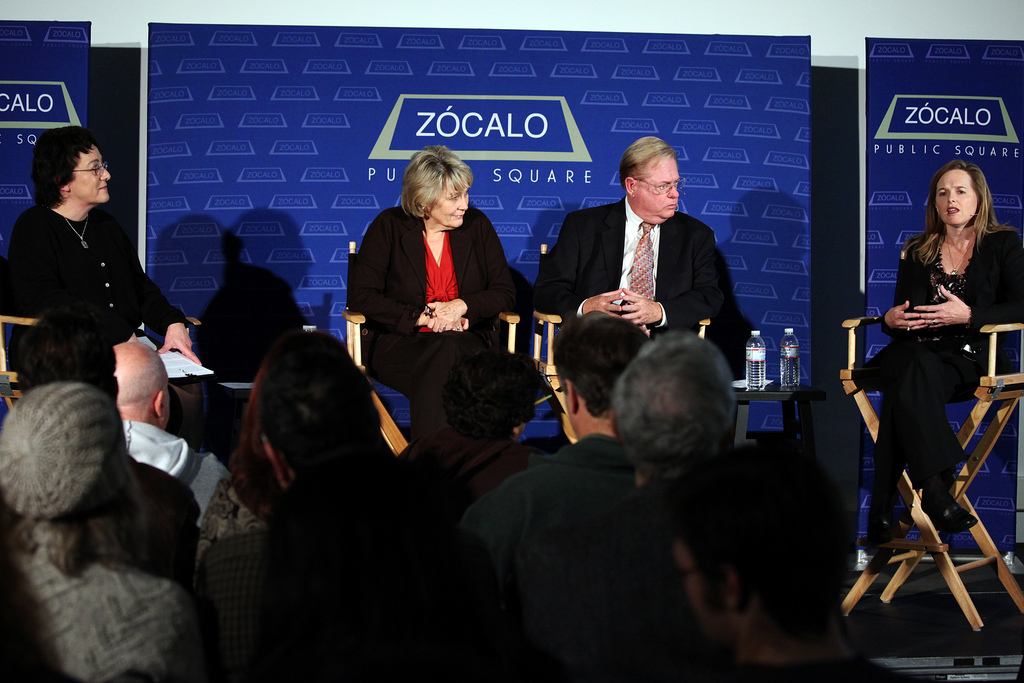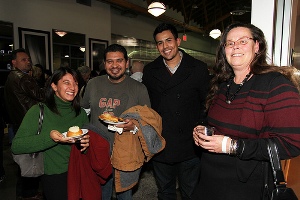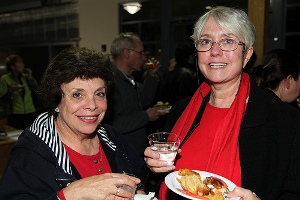
For those who haven’t had to consider caring for the elderly, long term care may a seem distant and not very pressing or merely basic issue – a matter of figuring out whether or not to rely on a nursing home.
But as Debra Saliba, director of the Anna and Harry Borun Center for Gerontological Research at UCLA, explained, “how we support persons with long-term care needs says a great deal about how we as a society care for our more vulnerable members.”
Saliba explained to the crowd at NPR West that though long term care options have expanded and improved over her career, the system is still “fragmented and very poorly coordinated,” with little clarity on best options, quality, and access.
In an event generously sponsored by the California HealthCare Foundation, Saliba joined California Culture Change Coalition Executive Director Bonnie Darwin, Gary Passmore of the Congress of California Seniors, and Gretchen Alkema of the SCAN Foundation to chat about what exactly long term care is, the problems we face in finding good care for ourselves or our family, and how to improve a system that all families encounter, sometimes in the most difficult of circumstances.
What to eat and where to live
 Long term care encompasses a large array of services that a large portion of the population requires, or provides, Saliba explained. While people of any age may need it, two-thirds of those who receive long-term care are over 65, and the older a person gets, the likelier they are to require such care. Seventeen percent of the 35 million Americans age 65 and older currently receive long term care; by 2030, there will be 70 million people over 65. As Americans grow older and life spans lengthen, healthcare costs are rising, particularly in the final six months of life, and demand for longer term is likely to increase. Already, 30 percent of Americans self-identify as providers of long term care; family and friends are the sole caregivers for 70% of the elderly.
Long term care encompasses a large array of services that a large portion of the population requires, or provides, Saliba explained. While people of any age may need it, two-thirds of those who receive long-term care are over 65, and the older a person gets, the likelier they are to require such care. Seventeen percent of the 35 million Americans age 65 and older currently receive long term care; by 2030, there will be 70 million people over 65. As Americans grow older and life spans lengthen, healthcare costs are rising, particularly in the final six months of life, and demand for longer term is likely to increase. Already, 30 percent of Americans self-identify as providers of long term care; family and friends are the sole caregivers for 70% of the elderly.
The category of long term care covers everything from assistance performing basic activities – like eating, bathing, shopping and housework – as well as full care in a home or assisted living environment. Alkema noted that many elderly also require interdisciplinary care from multiple sources, from meal services, support after hospitalization, legal and financial services, and social services.
People not parts
The range of care options can make it difficult to know what a family member needs, how to find it, and how to pay for it. As Passmore explained, most long-term care decisions are made at difficult times – such as when someone is in the hospital. Alkema added that the decisions often have to be made within a day or two and thus can’t be accomplished – bathrooms can’t be renovated, and front steps can’t be converted to a ramp, for example. And while these micro-level questions matter, the larger question to consider when choosing care is whether the person requiring care is comfortable in a nursing home or assisted living home, or whether they want to be as independent as possible, Passmore said. Maintaining independence is becoming the trend, he added, a positive development despite some safety concerns.
 A major hurdle for accessing care, Alkema, Passmore, and Darwin agreed, is cost. While public programs help the very poor, Passmore said, “there is this big vast middle.” In Los Angeles County, Alkema said, there are many services available, but most are paid for by the individual needing care or his or her family. Few, Darwin said, buy long-term care insurance in their 40s, when it’s affordable, and in any case, policies a decade or two old may already not fit today’s healthcare cost needs. Many elderly are also “reluctant to spend money on themselves,” she said. A nursing home can cost between $40,000 and $60,000 a year, Saliba said, though as Alkema noted, few people stay in them for a year.
A major hurdle for accessing care, Alkema, Passmore, and Darwin agreed, is cost. While public programs help the very poor, Passmore said, “there is this big vast middle.” In Los Angeles County, Alkema said, there are many services available, but most are paid for by the individual needing care or his or her family. Few, Darwin said, buy long-term care insurance in their 40s, when it’s affordable, and in any case, policies a decade or two old may already not fit today’s healthcare cost needs. Many elderly are also “reluctant to spend money on themselves,” she said. A nursing home can cost between $40,000 and $60,000 a year, Saliba said, though as Alkema noted, few people stay in them for a year.
For those who do have resources, the number of options is confusing, and coordinating care a daunting task. Alkema explained that older adults experience particular physiological changes – on top of their particular medical conditions. “Often times our healthcare system will focus on a particular body part or a particular condition and not think about the whole person,” she said. “It’s not about the congestive heart failure and the diabetes, it’s about, are they able to get inside their homes?” Everyone from the doctor to a part-time volunteer is part of a long-term care team, and better coordination and more training would help even though, Alkema said, “we could train 100 geriatricians a day and there would not be enough to support the aging of our population.”
The last secret
Once a family has accessed care, quality can be difficult to ascertain. “Sometimes we don’t appreciate that until we’re in a nightmare,” Passmore said. Nursing homes, despite some bad press, are “probably the most regulated, monitored, standardized part of the long-term care system,” he said. Most are inspected regularly, with requisite follow-ups and corrections. Warden care centers – usually run by an individual in a converted residence – are only inspected once every seven years, he said, which is “the lifespan of a frail elderly senior.” And California has no state standards for training home care workers. These workers have particularly difficult tasks and close relationships with the elderly, but because it is often a minimum wage role, “you can’t expect someone with a master’s in gerontology to come take care of grandma,” he said.
The result can be failures in care or even outright elder abuse, which Passmore described as “one of the really ugly unspoken problems in our society.” While child abuse became unacceptable a generation ago – and public and private systems arose to reinforce the norm – elder abuse “is the last secret.” Elders may be reluctant to report their family; families may feel uneasy approaching authorities. Abuse can range from the physical to the emotional – particularly where finances are involved.
 Consumers of long term care can only attempt to make the most informed choices, beginning, Darwin said, by making sure that the elderly person is as happy as possible with their care situation. The panelists noted that some websites, particularly the California HealthCare Foundation’s recently-launched CalQualityCare.org make it simpler to examine options for care — with explanations of types of care, a searchable database of ratings, and a quiz to determine the type of care you or your family member needs. And most importantly, families need to visit often and pay attention to care. “State inspectors are important, but when family visits frequently, nothing beats that in terms of quality,” Darwin said.
Consumers of long term care can only attempt to make the most informed choices, beginning, Darwin said, by making sure that the elderly person is as happy as possible with their care situation. The panelists noted that some websites, particularly the California HealthCare Foundation’s recently-launched CalQualityCare.org make it simpler to examine options for care — with explanations of types of care, a searchable database of ratings, and a quiz to determine the type of care you or your family member needs. And most importantly, families need to visit often and pay attention to care. “State inspectors are important, but when family visits frequently, nothing beats that in terms of quality,” Darwin said.
In lieu of reform, get hitched
A systemwide fix for long term care seems challenging to say the least, the panelists agreed. State budget cuts have slashed care for the elderly. “It makes as much sense to me to say let’s just close the I-5 because we can’t afford to fund a new lane,” Passmore said. No state or country, the panelists agreed in Q&A, provides an effective overall model for care, and even small-scale individual programs are hard to repeat.
Still, advocates are working to improve care. Darwin’s California Culture Change Coalition, realizing that “even the very very best nursing homes can be kind of depressing,” are working to transform nursing homes into something other than junior hospitals by reducing turnover and rotation of caregivers, for example. Long-term care insurance can help with costs, particularly if purchased in the late 40s or early 50s, even though insurers are struggling with rising costs, Passmore said. Some nursing homes – attempting to replicate the VA model – require face-to-face or virtual meetings of care teams, Saliba said, though doctors are typically missing. Other homes require the presence of a nurse practitioner to supervise care.
And for those who don’t want to wait around for improved care, there is one way to take matters into their own hands. To improve late life health, Saliba said, “The best plan of all is to get married and stay married.”
Watch the video here.
See more photos here.
*Photos by Aaron Salcido.




Send A Letter To the Editors